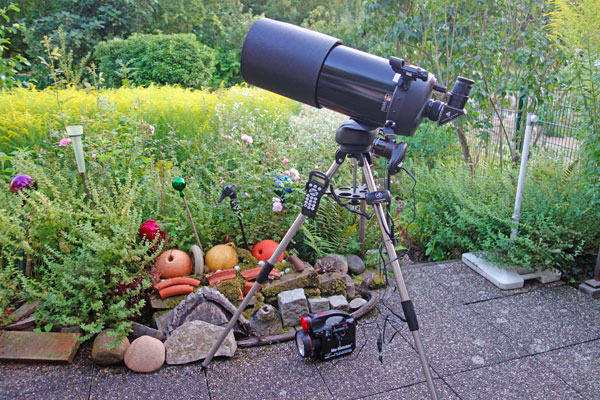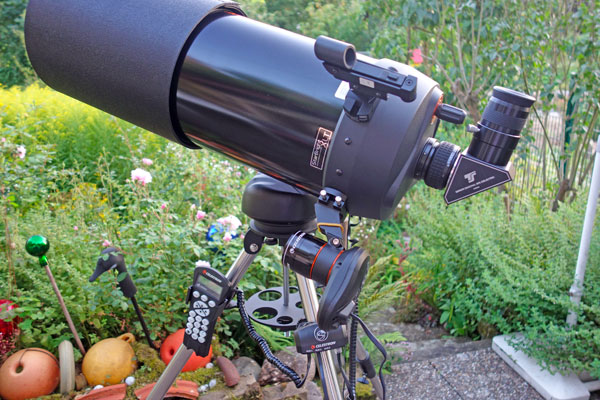Celestron StarSense AutoAlign for Sky-Watcher - Using it with a Celestron C8
On this page, I collect further experiences with and some information about my Celestron StarSense AutoAlign for Sky-Watcher module*, which I will call "StarSense module" for short in the following.
*) Ordered on February 1, from Teleskop-Spezialisten, arrived on February 7, 2018, sold in mid-November 2022.
Here, I present further experiences with my StarSense module, when I used it with my Celestron C8 tube on a Sky-Watcher Star Discovery mount (August 2021).
| Note: In mid-November 2022, I sold my Celestron StarSense AutoAlign for Sky-Watcher module. I therefore can no longer report any experiences with the StarSense module here. I also sold my Celestron C8 in the beginning of November 2022. |
See also:
- Celestron StarSense AutoAlign for Sky-Watcher Information Archive
- Celestron StarSense AutoAlign for Sky-Watcher - First Experiences Archive
- Celestron StarSense AutoAlign for Sky-Watcher - Further Experiences Archive
- Celestron StarSense AutoAlign for Sky-Watcher - Connecting to a Mac (USB) Archive
- Celestron StarSense AutoAlign for Sky-Watcher - Using it with a Celestron C8 Archive
- Sky-Watcher AZ GoTo Mounts (Star Discovery, AZ-GTi) - Instructions Archive
Introduction
For a long time I had not used my Celestron StarSense module, especially since I had sold my Sky-Watcher Explorer 150PDS, for which I had calibrated the module. Besides the lack of a calibrated tube, many reasons played a role in this, among others the competition from other devices, but also the ultimately low success I had, at least felt, with the StarSense module.
In August 2021, I received an inquiry whether I would like to sell my C8. I was undecided and decided to do some tests and comparisons, especially with the smaller Celestron C5. Of course, the Sky-Watcher GoTo mounts also played a role, the AZ-GTi for the C5 and the Star Discovery for the C8, with the GoTo behavior of which I had not had particularly good experiences in 2021. This gave me the idea to finally try the StarSense module once again and calibrate it for the C8 for this purpose. In the following, I simply describe the experiences that I made and also discuss, which consequences result from this when using astronomy cameras.
StarSense at C8 (August 14, 2021)
Equipment
C8 on Star Discovery mount with StarSense module and handbox, 26 mm eyepiece (2"; 78 x; 0.9°) and a few times 16 mm eyepiece (1.25"; 127 x; 0.65°), 2" zenith mirror; SkyWatcher PowerTank. Setup time about half an hour.
 |
 |
 |
This was meant as a test to find out whether the C8 can be operated with the StarSense module. For this purpose, a new calibration was necessary, which I did successfully according to my instructions (Arcturus for calibration; from 10 p.m. on; SQM 19.8). Time/location settings: current time, Frankfurt.
Targets
I observed until midnight at maximum SQM 20.1; at the end SQM 20 again...
- M 13: very nice, resolved into stars; immediately found centered, but quickly slipped a bit to the edge; manually centered, but slipped again to the edge (but then stayed there...).
- M 92: also nice, smaller, also resolved into stars; also drifted to the edge, but then stayed there.
- M 57: ring nicely visible; not quite at the center
- M 27: very "fuzzy"; quite left at the beginning, centered manually (should have used my UHC filter...)
- M 56: faint, smaller than M 13/M 92; was left at the beginning, centered manually
- M 51: very faint, but two dots visible, hardly more; was also not centered, but more to the upper right; centered manually
- M 11: very nice and large; almost centered
- M 71: faint, but nice, smaller than M 13/M 92; stood left at the beginning, centered manually
- M 16: nebula not found, only the star cluster was good to see
- Saturn: very nice, also with 16 mm eyepiece; moons seen but not identified; not centered, but in the field of view
- M 17: nebula faint, but visible (was horizontal...); centered
- M 14: rather faint and not resolvable; centered
- M 10: larger and brighter than M 14, resolvable into stars
- M 12: again fainter and not resolvable
- M 15: much brighter than the previous globular clusters, quite resolvable (SQM 20.1); only found in 2nd attempt (GoTo repeated; far away from M 12 & company)
- M 51 (da capo): still very faint; quite right at the beginning.... (longer way from M 15)
- M 57 (dacapo): the second attempt was probably a bit better (darker sky)
- M 3: not found; quite low and the sky there quite bright and starless
- Jupiter: very bright, rings hard to see, 4 moons recognized; found only on 2nd attempt (GoTo again)....
- Arcturus (alignment test): found only after 3 GoTo attempts (right); thereupon alignment repeated...
- M 3 (da dacapo): rather faint; but now found!
21 targets approached including Arcturus, of which 3 are repeats (so 18 targets...). At the end, a bit after midnight, SQM 20...
Conclusions
Only a few targets were exactly centered after approaching them via GoTo, but except for Arcturus and nearby M 3, all targets were within the field of view of 0.9°, although a few of them only after issuing a new GoTo command (and two more at Saturn...); possibly due to longer paths to the next target...
Tracking seems to have worked, but I only spent a few minutes on each target.
All in all, if everything works fine, I find using the StarSense module much more pleasant than a "usual" GoTo control!
Question: What Does this "Visual" Result Mean for the Use of Astronomy Cameras Together with the StarSense Module?
The following table shows the fields of view of my telescopes and astronomy cameras, as well as other popular cameras:
Field of View |
|||||||||
| Telescope | Red. | FL | Apert. | Atik Infinity | ASI224 | ASI178 | ASI533 | ASI294* | Remarks |
Pixel Size > |
6.45 µm | 3.75 µm | 2.4 µm | 3.76 µm | 4.63µm | ||||
Pixels > |
1392 x 1040 | 1304 x 976 | 3096 x 2080 | 3008 x 3008 | 4144 x 2822 | ||||
| PS 72/432 | --- | 432 | 72 | 1.19° x 0.89° | 0.65° x 0.48° | 0.98° x 0.66° | 1.50° x 1.50° | 2.54° x 1.73° | The largest FOV |
| C5 | --- | 1250 | 127 | 0.41° x 0.31° | 0.22° x 0.17° | 0.34° x 0.23° | 0.52° x 0.52° | 0.88° x 0.60° | FOV like C8 with reducer |
| C5 | f/6.3 | 787.5 | 127 | 0.65° x 0.49° | 0.36° x 0.27° | 0.54° x 0.36° | 0.82° x 0.82° | 1.40° x 0.95° | FOV a little smaller as with TLAPO1027 |
| C8 | --- | 2032 | 203 | 0.25° x 0.19° | 0.14° x 0.10° | 0.21° x 0.14° | 0.32° x 0.32° | 0.54° x 0.37° | The smallest FOV |
| C8 | f/6.3 | 1280 | 203 | 0.40° x 0.30° | 0.22° x 0.16° | 0.33° x 0.22° | 0.51° x 0.51° | 0.86° x 0.58° | FOV like C5 |
| TLAPO1027 | --- | 714 | 102 | 0.72° x 0.54° | 0.39° x 0.29° | 0.60° x 0.40° | 0.91° x 0.91° | 1.54° x 1.05° | FOV a little larger that for C5 with reducer |
| eVscope | --- | 450 | 114 | --- | 0.61° x 0.46° | --- | --- | --- | Same chip as ASI224 |
*) In my possession (October 2024)
The results presented above are based on an field of view of 0.9° (26 mm eyepiece, 2", 70° field of view); only a few objects were indeed "centered" after the GoTo access, many were located somewhere at the edges of the field of view. This would mean that most of the objects would be out of the field of view with my astronomy cameras - some more, some less. That would mean quite a lot of search, especially with the ASI224 (no longer in my possession) at the C8 without a reducer - and with a reducer, as well...
Preliminary Conclusions
It is still too early for any conclusions in this matter... Further observation
sessions should confirm now that the StarSense module can be operated hassle-free
and "without
bellyache" by me at my Celestron C8 on a
Sky-Watcher Star Discovery mount. If this works out, I would perhaps think
again about a connection to SkySafari - or the use of an astronomy camera (with
a sufficient field of view*)...
*) Since April 2022, I own the ZWO ASI294 with a large FOV, which however vignettes at the C8.
Links
- Celestron Website, USA: www.celestron.com
- Product page: www.celestron.com/products/starsense-autoalign (for Celestron only) - www.celestron.com/products/starsense-autoalign-for-sky-watcher-mounts (for Sky-Watcher)
- Celestron, Germany (Baader-Planetarium): www.celestron-deutschland.de
Product page: www.celestron-deutschland.de/product.php?CatID=31&ProdID=1147 (for Celestron only) - www.celestron-deutschland.de/product.php?CatID=31&ProdID=1362 (for Sky-Watcher) - Pages from German distributors for the Celestron StarSense for Sky-Watcher:
- Teleskop-Spezialisten (here the module was bought): www.teleskop-spezialisten.de/shop/Montierung-Zubehoer/Nachfuehrung-und-GoTo/Celestron-StarSense-fuer-GoTo-Montierungen-automatische-Eichung-Alignement::1914.html (for Celestron only, in German) - www.teleskop-spezialisten.de/shop/Mounts-Accessories//::1914.html?language=en (for Celestron only, in English) // www.teleskop-spezialisten.de/shop/Montierung-Zubehoer/Nachfuehrung-und-GoTo/Celestron-StarSense-AutoAlign-fuer-Skywatcher-Montierungen::2096.html?language=de (for Sky-Watcher, in German) - www.teleskop-spezialisten.de/shop/Mounts-Accessories//::2096.html (for Sky-Watcher, in English)
- Teleskop-Service/Express: www.teleskop-express.de/shop/product_info.php/language/en/info/p6040_Celestron-StarSense-fuer-GoTo-Montierungen---vollautomatische-Eichung.html (for Celestron ony, in English) - www.teleskop-express.de/shop/product_info.php/info/p9016_Celestron-StarSense-AutoAlign-for-Skywatcher-mounts.html (for Sky-Watcher, in English)
- Astroshop: www.astroshop.eu/controls-with-goto/celestron-starsense-module-including-hand-controller/p,32954 (for Celestron only, in English) - www.astroshop.eu/controls-with-goto/celestron-starsense-autoalign-for-skywatcher-synscan-mounts/p,51606 (for Sky-Watcher, in English)
- Michael Swanson's NexStar Website: www.nexstarsite.com (PC connection: https://www.nexstarsite.com/PCControl.htm, drivers: https://www.nexstarsite.com/PCControl.htm/USBDrivers.htm)
- Mac OS X Universal Binary Driver v1.6.2 (Prolific): www.prolific.com.tw/US/ShowProduct.aspx?p_id=229&pcid=41 (link does not work on my computer); version 1.6.1: prolificusa.com/pl-2303hx-drivers (works on my computer)
- Michael Swanson (2017). The NexStar User's Guide II. Springer. Softcover ISBN: 978-3-319-64932-0 (link)
- NexStar Communication Protocol: www.nexstarsite.com/download/manuals/NexStarCommunicationProtocolV1.2.zip (found on Michael Swanson's page www.nexstarsite.com/PCControl/ProgrammingNexStar.htm)
- See also my page offering Astronomy Links.
| 28.11.2024 |